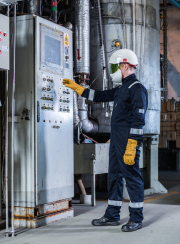With temperatures more than four times hotter than the surface of the sun, it goes without saying that workers must be fully protected against the dangers of an Arc Flash. And for those working in the industrial electrical industry, working around high and low voltage electricity on a daily basis means workers are at increased risk. Here, Mark Lant, Technical Expert at Arc Flash protection specialists, ProGARM, explains his top five tips to protect your team from the potentially fatal or life-changing consequences of an Arc Flash…
Educate your team
If your team doesn’t properly understand the dangers posed to them by Arc Flash hazards because they haven’t been explained properly, then they may not wear the clothing correctly, leaving them vulnerable to the risks of an Arc Flash.
Training a workforce is essential to ensuring optimum safety levels on the ground. It’s of paramount importance that those in the field are aware of the dangers around them, as well as how to wear their PPE correctly. Understanding how to minimise exposure to risk, as well as safe working practices and using equipment properly, significantly reduces the chances of an Arc Flash incident occurring in the first instance.
However, regardless of precautions taken, sometimes such incidents can still occur, meaning PPE must always been worn correctly. For example, an unzipped or partially zipped Arc Flash jacket will leave an operative exposed to potentially life-threatening or life-changing injuries. Similarly, Arc Flash protection can be compromised by wearing non-AF garments underneath. In short, the more knowledge workers have around the dangers of an Arc Flash and other risks, the less likely it is that an incident will have serious consequences.
Use the experts
Getting to know the dangers, risks and technical language in any industry is challenging, but for those working in the industrial electrical industry, a lack of understanding around key terms can put lives at risk. With so much technical language around the subject of Arc Flash, it’s difficult to know where to start. However, it’s important to familiarise yourself with key terms such as: Arc numbers; treated and inherent fabrics; and thermal energy. Use experts like ProGARM to help you and your team fully understand the language and the dangers surrounding the subject of Arc Flash safety and protection.
Equip workers with all PPE layers
Wearing everyday clothing underneath Arc Flash PPE leaves workers at risk of serious burns, should an Arc Flash occur. While the flames caused by an Arc Flash may not actually come into contact with skin through the protective outer layers, the extreme heat can melt the materials used to manufacture everyday undergarments, including nylon, cotton, and polypropylene.
This means all layers, including vests, leggings, thermals, socks and even underwear should be the right specification so that they don’t compromise the protection.
Arc Flash vs Flame Retardant
While many think flame retardant (FR) PPE can provide the same level of protection against an Arc Flash, there are in fact separate safety standards for Arc resistant clothing. The characteristics of an Arc Flash means that the level of protection provided is different and some ways far greater. This makes it essential that you and your team are up to speed on the crucial differences and those at risk are fully kitted out in Arc resistant PPE.
Understand the relevant standards
A new version of IEC 61482-1-1 has been published, changing the way Arc Flash garments are rated. ELIM is the new cal/cm2 measurement and it’s the point at which there is 0% second-degree burn probability at any given incident energy level. Previously, ATPV measurements calculated the incident energy level at which there’s a 50% probability of second-degree burns.
Under the new ratings, a product could now have a lower Cal rating compared with its ATPV rating, despite it being the same garment. This means that to achieve 8cal ELIM protection, wearers may be required to wear Arc Flash base layers underneath their outer PPE, to increase the layers of Arc Flash protection, or wear a heavier garment to provide the ELIM value if required.







